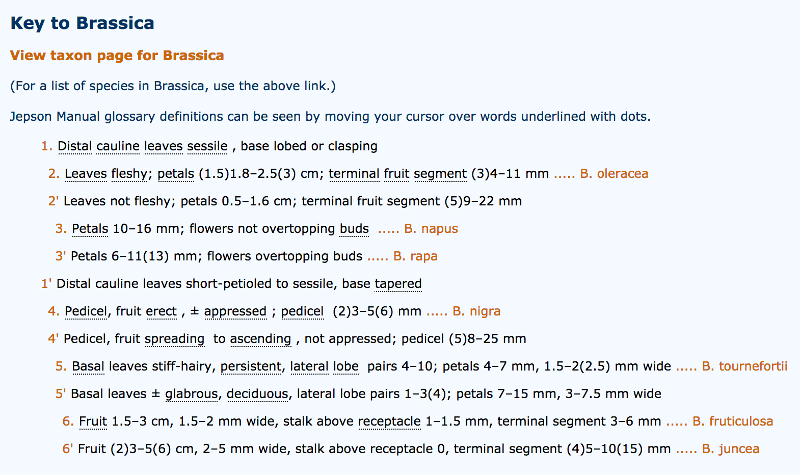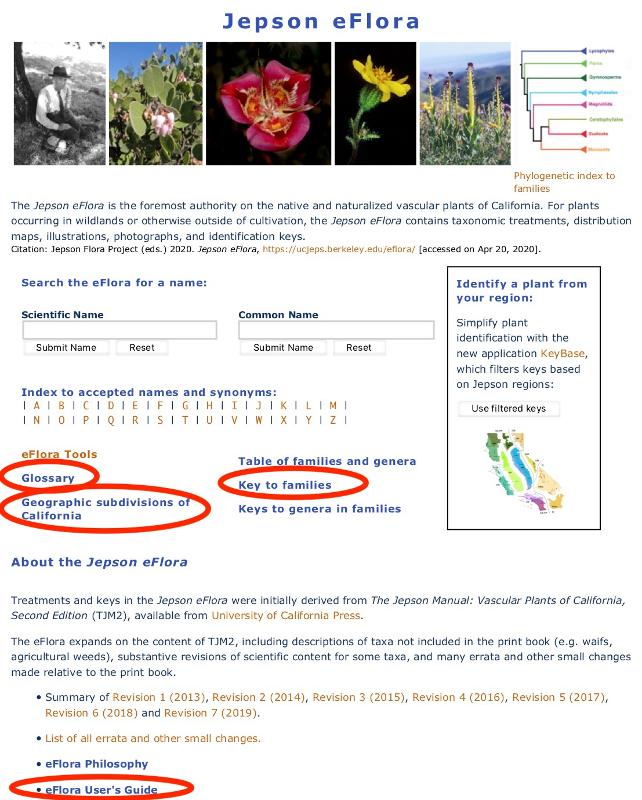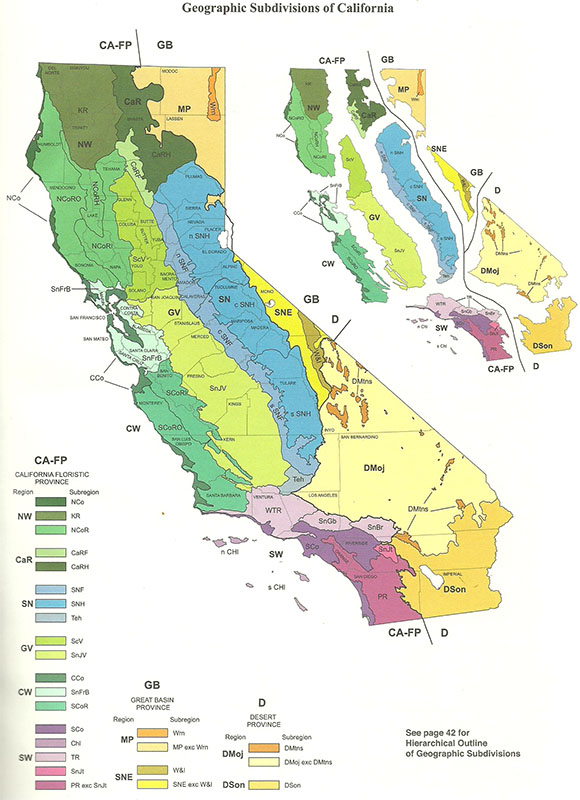
Using the Jepson eFlora
Dichotomous keys are tools for identifying organisms (or things) by making a series of choices or decisions.
An example (a key to species that are in the genus, Brassica) is shown below.

The first decision you must make is between 1 and 1'.
If you decide on 1', your next choice is between 4 and 4'. Always move to the choice directly below the statement you have decided is correct. If you choose 1', choices 2 vs 2' and 3 vs 3' are irrelevant; you will not have to make those choices.
In our example, if you decide 4 is correct and reject 4', you have (potentially) identified your species as Brassica nigra. If, however, you decide that 4' is correct, your next choice would be between 5 and 5'.
Notice that a statement in a key choice often has several parts. Look at every part. For example, your first choice in this key is:
1. Distal cauline leaves sessile, base lobed or clasping
vs.
1'. Distal cauline leaves short-petioled to sessile, base tapered
If the plant you are looking at has sessile leaves, the first part of these statements won't help you. You could go either way with a sessile leaf. You should, however, be able to make the decision based on the shape of the bases of the distal cauline leaves.
There are many ways to make a key, and different sources (different identification manuals with different keys) may use different characteristics, or the keys may begin with a different set of characteristics. If you find it difficult to identify a plant with one key, sometimes it helps to use a different one. We will just be using the Jepson Manual in this class, though.
The Jepson Manual is a huge dichotomous key to native and naturalized plant species in California.
The key is broken up into sections.
Some keys are so large that they are broken into 'groups' that then have their own keys. This is just to make the size of the keys more manageable.
Finally, there is a description of each species. This description gives the species' characteristics, its geographic range (where it is found in California), its elevation range, and the plant communities it inhabits. It also tells whether the plant is native or introduced to California.
Here is an example of the description of Brassica nigra with links back to higher taxonomic levels (description and keys for the family and genus it is in).

Before we begin keying a plant, familiarize yourself with the resources on the main page of the Jepson eFlora (https://ucjeps.berkeley.edu/eflora/). A screenshot highlighting important links is shown below

The Key to families is where you will normally start in trying to identify a plant. (Once you learn to recognize some families, you can skip this step and go straight to the key to genera within a family.)
A Glossary is available, defining words you may not know.
The Geographic subdivisions of California is useful both for identifying plants and confirming identifications. Some places in the key will ask you choose between "ChI" (Channel Islands) and "mainland". (There are many species that are endemic to the Channel Islands.) Species descriptions also give the known range of the species. Although ranges may be shifting, the stated ranges can help confirm or reject a possible identification. For example, if you identify a plant from the San Bernardino Mountains as a species that is said to occur only on the Modoc Plateau, you should probably doubt your identification. The map from the print version of the Jepson Manual (Baldwin et al. 2012) is reproduced here:

Note that there are three major subdivisions of California: The California Floristic Province (from the major mountain ranges to the coast), the Great Basin Province (the transmontane or eastern/desert side of the mountains in the northern part of California), and the Desert Province (the transmontane region in the southern part of California). Each of these are subdivided into smaller and smaller regions.
CSUSB is at the base of the San Bernardino Mountains (abbreviated SnBr in the species descriptions), which is part of the transverse ranges (abbreviated TR, colored light pink above), which is part of the Southwestern California Region (abbreviated SW and colored pinks to purples above), which is part of California Floristic Province (Ca-FP).
Finally, there is a link to an "eFlora User's Guide" on the main page of the Jepson eFlora. If something is confusing in a key or description, read this. For now, the main thing to learn is the importance of punctuation in the key statements and descriptions:
Example 1: In the statement, "Fruit 3--4 mm, ovoid; segments 10--14, margins winged, tips bristly (or segments 8--9, margins rounded, tips glabrous)," ... "tips" refers to tips of "segments," not to tips of "margins" or tips of "Fruit". Winged margins and bristly tips both describe the segments (the first word - a noun - after the semicolon).
Example 2: "in statements such as "bristles with barbs," any text that might follow does not describe "barbs," unless "barbs" is repeated)." The text would describe the bristles, until you come to another semicolon.
Check your understanding:
Before you begin keying, examine your plant carefully. This will make it possible to move through the key much more quickly.
1) Plant habit or life form: Is the plant an annual, perennial, shrub or tree? (Hint: annuals usually have wimpy roots and they flower their first (and only) year; herbaceous perennials tend to delay flowering until the second year or later and you may be able to see remnants of last year's stems.)
2) Flowers: Is the flower perfect or imperfect? radial, bilateral, or biradial? How many sepals, petals, stamens, and pistils does the flower have? Is the ovary superior or inferior? Are any flower parts fused to each other?
3) Leaves: Are leaves simple, palmately compound, pinnately compound, or something else? Do the leaves have stipules? Are the leaves sessile? What shape are the leaves? Are the leaves opposite, alternate, or whorled?
Return to the Blackboard website and view the images for your unknown plant. Make notes on the features above.
Once you have made notes about this plant's characteristics, open the Jepson eFlora's main page (https://ucjeps.berkeley.edu/eflora/) and begin with the Key to Families. Work through this key, making notes of which choices you made. There are some (many) instances in which a choice is not clear. (You may not have the plant part that the key refers to, etc.) It is useful to keep a record of your choices, make a note of where you were uncertain, and return to that branch point in the key to pursue both branches.
For this particular exercise, you will need to enter your choices (e.g., 1 or 1') on the following pages, so keep track of them.
Key as far as you can, then come back and check yourself.
For species identification, see the instructions on the last page: "Find the right species"
Enter the choices you made in the first part of the Key to Families. If you did not get to the correct Group in the Key to Families, hints will be given to get you back on track.
You can click on the Group name in the Key to Families to bring up a key to families in that Group.
You can click on the Group name in the Key to Families to bring up a key to families in that Group.
Enter your choices in that part of the key below. If you did not get to the correct family the first time, hints to incorrect answers on this page should get you back on track.
In this particular case the Key to Families took you straight to the genus. That is usually not the case. Normally, you would be taken to a key to genera within a specific family. You can navigate to that key from the genus page, if you want to.
On the page for the genus, there is
1) a link to both a description for the higher taxonomic level (in this case, the family) and a dichotomous key for that family.
2) a general description of plants in the genus
3) a link to a key to species within the genus (below the genus description), then
4) a drop-down menu with a list of species in that genus.
You should be able to key through the first two steps of this key, then it gets more difficult. Try it and check your first two steps.
Your third step is choosing between 4 and 4'. There is a bit of conflicting information at this point that makes the choice difficult.
There are several characteristics to compare:
1) Whether the inflorescence is open or dense is a bit difficult to tell without being able to compare an open and a dense inflorescence.
2) There are more than 10 flowers [in an inflorescence] in those inflorescences that were photographed. That favors choice 4'.
3) The petiole is fairly close to 2 cm long (see petiole photo). Choosing between petioles > 2 cm and petioles < 2 cm, is not useful. (Additionally, the words "generally < 2 cm" for choice 4, and "petiole generally > 2 cm (0-3 cm in Berberis pinnata)" for choice 4', mean there are exceptions.)
4) Is the shape of the terminal leaflets "lanceolate, oblong, or narrowly elliptic" (choice 4), or "ovate to wide-elliptic" (choice 4')? The one in the "leaf" photo looks oblong to me, but another ("leaf2") looks slightly ovate. ...difficult to tell.
This is a case in which I would key both ways, then compare the descriptions of the candidate species.
Assignment:
There are 11 taxa (species, subspecies, and varieties) past this point in the key. This part of the assignment is more easily assessed (by me) in a quiz format. Therefore, the quiz that follows this lesson will ask you about each of these 11 taxa. For each, you will be asked why you eliminated them or why you chose the. You should use information from the key and/or from the description, and/or from other sources (e.g., CalPhotos or Calflora.
Reminder: If you did not initially enter the correct answers on the fourth page of this lesson ("Start keying"), go back and correct your answers before submitting.